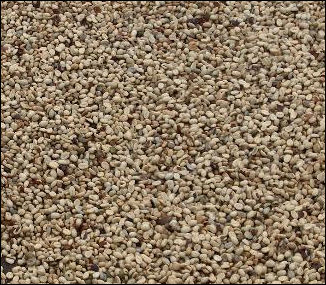COFFEE
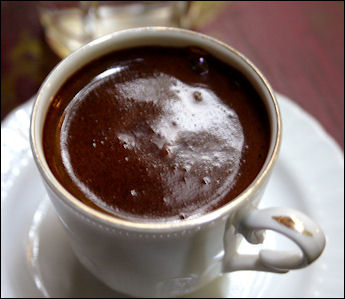
Turkish coffee Coffee comes from a red seed (bean) of the coffee plant, a tropical plant that grows about as high as a man. The second most popular hot drink in the world after tea, it is made from water brewed in roasted and ground coffee beans. Coffee has 800 to 1,200 flavor components. Its attractions are its taste and the pick-me-up from the stimulant caffeine. [Source: Ethel Starbird, National Geographic, March 1981 [└];
A person who drinks two cups of coffee a day, consumes the annual harvest of 18 coffee trees. To make good coffee you should: 1) make sure the coffee pot is clean; 2) uses fresh or freshly ground coffee and cold water; 3) use the maximum capacity of the coffee maker; 4) measure accurately, two tablespoons for six ounces of water; 5) find the extract time to produce the best coffee; 6) never allow the coffee to boil; 7) serve as soon as possible after brewing; 8) follow any special institutions provided by the manufacturer.
World’s Top Producers of Coffee, Green (2020): 1) Brazil: 3700231 tonnes; 2) Vietnam: 1763476 tonnes; 3) Colombia: 833400 tonnes; 4) Indonesia: 773409 tonnes; 5) Ethiopia: 584790 tonnes; 6) Peru: 376725 tonnes; 7) Honduras: 364552 tonnes; 8) India: 298000 tonnes; 9) Uganda: 290668 tonnes; 10) Guatemala: 225000 tonnes; 11) Laos: 185721 tonnes; 12) Mexico: 175555 tonnes; 13) Nicaragua: 158759 tonnes; 14) China: 114000 tonnes; 15) Costa Rica: 76008 tonnes; 16) Tanzania: 60651 tonnes; 17) Philippines: 60641 tonnes; 18) Cote d’Ivoire: 59412 tonnes; 19) Venezuela: 57100 tonnes; 20) Madagascar: 42220 tonnes. [Source: FAOSTAT, Food and Agriculture Organization (U.N.), fao.org. A tonne (or metric ton) is a metric unit of mass equivalent to 1,000 kilograms (kgs) or 2,204.6 pounds (lbs). A ton is an imperial unit of mass equivalent to 1,016.047 kg or 2,240 lbs.]
Book: “Coffee: A Dark History” by Antony Wild (W.W. Norton, 2005)
Websites and Resources: History of Coffee National Geographic National Geographic ; Coffee Research coffeeresearch.org/agriculture/coffeeplant ; International Coffee Organization ico.org/ ; Coffee Geek coffeegeek.com ; SinPari Trading: sinpari.com/Coffee_History_Cultivation.html ; Wikipedia article Wikipedia ; Coffee Facts coffeefacts.org ; Coffee Trail guardian.co.uk/news ; Farming and Processing coffeeterms.com/coffee-farming-and-processing
See Separate Article COFFEE: CULTIVATION, PROCESSING, PRODUCERS AND PRICES factsanddetails.com
Robustas and Arabicas
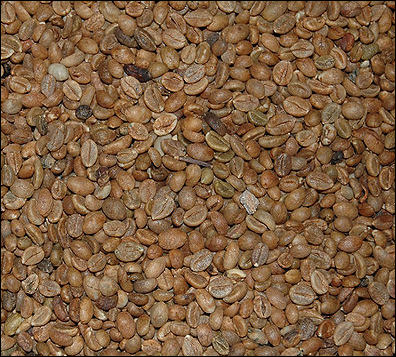
robusta Most coffees fall into two categories: 1) slightly bitter robustas made with robusta beans, traditionally produced mostly in Asia and Africa; 2) and milder arabicas made with arabica beans, traditionally produced primarily from Latin America. These days both robustas and arabicas are produced all over the world.
Arabicas are regarded as the best quality. They have a smooth flavor and low acidity and are ideal for premium coffees, espresso and gourmet coffees. They are used in many of Starbucks’ concoctions. Roasting companies use them to soften their commercial brands.
Robusta beans are regarded as lower quality. Used to make instant coffee and espresso, they are often exported as green beans, which grinders like Nestles and Sara Lee used mainly to make instant coffee, supermarket canned coffee and packaged coffee drinks. Robustas contain almost twice as much as caffeine as arabica beans. They have twice as much caffeine as arabicas. A typical cup of robusta coffee has 150 milligrams of caffeine while a typical cup of arabica coffee has 70 to 100 milligrams of caffeine
Types of Coffee
“Espresso” (literally "pressed out") is very strong coffee served in little cups and made with a completely different process than that used for normal percolated or brewed coffee. It is made passing water rapidly through packed coffee grounds at high pressure, which causes the oils and other products in the coffee to be more fully extracted. The result is a coffee with a much stronger and richer flavor. A cup of espresso typically contains1.5 to 2.0 ounces of liquid, much less than a typical cup of brewed coffee but has about the same amount of caffeine as a cup of arabica coffee.
raw arabica
“Cappuccino” is a frothy mix of coffee and milk made with a special machine. It is made by adding a shot of espresso with milk and blowing it into a froth. Other European coffee drinks — such as “caffe macchiato” , coffee with a drop of milk, “caffe latte” , coffee with a lot of milk, and “caffe correcto” , coffee with brandy — and also made with a shot of espresso.
Real mocha from Yemen and real java from Indonesia were originally arabicas produced in the places they were named after, but today real mocha is practically non existent and the coffee beans grown on Java now are disease-resistant robustas introduced after leaf rust wiped out many of the island's arabicas plants about 30 years ago. The javas and mochas you see in the coffee stores are high grade arabicas grown elsewhere. Coffees are then described their country of origin or a region within the county. They sometimes given catchy names or described as "low-grown” or "high grown" Dark roasted coffees have been roasted a longer time. They have less caffeine.
Kopi Luwak is said to be the world’s rarest and most expensive coffee. It is brewed from beans hand-picked from civet dropping. Civets are tree-dwelling nocturnal animals that resemble a cross between a weasel and a leopard. They have a special gland that produces a scent coveted in the perfume industry. A cup of Kopi Luwak sold at Australia’s Heritage Tea Rooms goes for $42 a cup. The estimated global production of Kopi Luwak is only around 300 kilograms.
Early History of Coffee
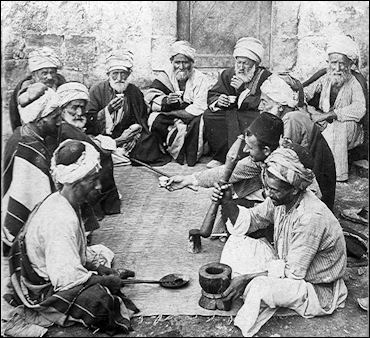
Enjoying coffee in Palestine Coffee originates came from Kaff province of Ethiopia, the source of the name coffee. According to legend, it was discovered in A.D. 850 by a goat herder named Kaldi, who noticed how lively his flock became after munching red beans from a coffee plant and then tried some himself and became as upbeat as his goats.
In the early days of coffee, people simply chewed the berries. Many years passed before someone thought of making a drink from them. Arab trader decided to boil the coffee beans they got from Ethiopia.
Around A.D. 1000 the first cup of coffee, or "bean broth," was prepared in Yemen, across the Red Sea from Ethiopia, where coffee was grown in the mountains. The drink became popular throughout teetotaling Muslim world and became known as the “the wine of Araby.” Before long mullahs were complaining that their followers were spending more drinking coffee than were praising Allah.
Raw coffee doesn't brew into anything pleasant. In the 13th century, someone decided to roast the berries, which releases a pungent oil that produce the familiar coffee aroma, The first recorded consumption of coffee as we know it today took place in the 15th century by Sufi mystics who used the drink in their rituals.
Coffee in Turkey and Europe
The Ottoman empire took over the coffee trade when they took over Yemen. The oldest known coffee houses were opened in Constantinople in 1554 by two merchants. As well as places to hang out they were became known as "schools of the cultured." At this time Al-Makha (Mocha) in Yemen was the focal point of the coffee trade.
Turkish coffee became so popular in Istanbul that women were allowed to divorce their husbands if they couldn't keep the “ibrik” , or pot, filled. Turkey never grew its own coffee, and the drink was popular only when the Ottoman empire was rich enough to import large quantities of beans. Turkish soldiers drank it as the besieged Vienna in 1683.
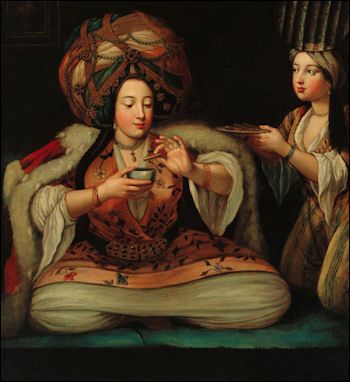
Enjoying coffee in the 18th century The Ottomans in turn introduced coffee to Europe. Venetians merchants carried the first cargo of coffee from Turkey to Italy in the late 16th century. By 1618, the English and Dutch had set up coffee factories in Al-Makha (Mocha) in Yemen and made a killing when coffee houses became all the rage in the late 1600s.
The first coffee houses opened in Venice and Amsterdam in the 1630s. Coffee was introduced to France during the court of Louis XIV by a Turkish ambassador in 1669 The world's first café was opened on a street called rue de l'Ancienne Comédie Paris in 1686 by a Sicilian named Francisco Propio, who sold coffee as well as fruits syrups, tea, liqueurs, chocolate, “glaces” (proto-ice-cream). By the 1723, there were 300 cafés in Paris and 800 by 1800.
By 1750 coffee houses called "penny universities” had sprung up all over western Europe. Such venerable institutions as the Freemasons, Britain’s Royal Society and Lloyd’s of London all got their start in coffee houses in Britain. Some even go as far to say that the Enlightenment was given a boost by caffeine-sparked conversations and thoughts.
The Catholic church initially denounced coffee as the drink of infidels, but later, according to one story, baptized it and gave it Christian status because Pope Clement liked the drink so much he felt it would be a shame if it remained solely in the hands of Muslim infidels.
Later History of Coffee
Yemen and Al-Makha had a monopoly in the coffee trade until the 18th century when some coffee plants were smuggled out and used to establish a plantation in Ceylon. Once the monopoly of trade from Mocha was broken, coffee cultivation spread all over the world, namely to European colonies in Asia and the Americas. All the early coffee grown in the America was said to evolved from a single plant brought to the island of Martinqiue in the early 1700s by French captain. Later it was cultivated by the Dutch in the East Indies.
Raising and producing coffee is very labor intensive work. In the Americas coffee was a central part of the slave economy along with sugar and cotton. Slavery remained part of coffee agriculture in Brazil until the 1880s.
Coffee played in role in the establishment of the United States. After the Boston Tea Party Americans began drinking coffee to show their distaste for British tea taxes. The Green Dragon Coffee House in Boston was where the Boston Tea Party and the American Revolution were planned.
Coffee houseCoffee’s rise coincided with the Industrial Revolution. It replaced beer as the drink of choice and it seems plausible that the switch improved productivity and safety as workers were more alert and less likely to dose off while working with dangerous machines. Boiling water to make coffee and tea decreased the incidence of disease among workers in crowded cities.
For many years people simply boiled water with ground coffee and poured it through a filter into a cup. The coffee pot was invented around 1800 in France. Methods for making decaffeinated coffee were invented in the early 1900s. Instant coffee was invented by Nestle in the 1930s in response to a bumper crops of coffee in Brazil and a request by the Brazilian government to help them figure out a way to store the large coffee surpluses. Nestle named its commercially-sold instant coffee Nescafe. Nescafe remains the word used in many parts of the world to describe instant coffee.
The Juan Valdez campaign launched in the 1960s not only promoted Columbian coffees it also educated consumers about how coffee was produced. The Starbucks phenomena, which really took hold in the 1990s, is credited with opening up the gourmet coffee making while at the same time masking coffee flavor with lots of milk, sugar and blueberries and nuts.
Coffee and Caffeine
Coffee contains more caffeine than tea. The caffeine content of coffee can range from 60 to 180 milligrams per cup depending on blend of coffee beans, method of preparation and length of brewing time, compared to 20 to 90 milligrams per cup of tea. A typical cup of brewed coffee contains 100 milligrams of caffeine, compared to 40 milligrams for typical cup of tear-bag-brewed tea. A cup of decaffeinated coffee has 4 milligrams of caffeine.
Caffeine has a stimulating effect, and is credited with increasing energy and alertness. It is created by enzymes in the coffee bean that combine methyl group chemicals with chemicals called xanthosine. In the human brain it affects a group of chemical messengers called adenosines, which in turn affect a variety of other chemical messengers. One possible explanation of caffeine’s stimulating effect is that it blocks the mitigating effect of adenosines, which allow natural stimulants in the body to have a stronger affect on the brain. Some heavy coffee drinkers suffer from coffee addiction and endure withdrawal symptoms
Caffeine
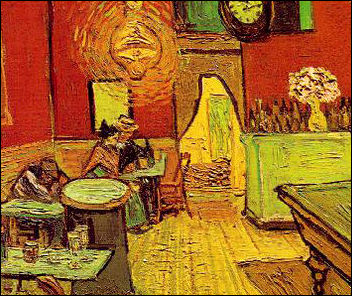
Van Gogh's Night Cafe By some estimates caffeine is the world’s No. 1 mood-altering drug. It is found not only in coffee, tea and energy drinks but also in diet pills and pain relievers as well as chewing gum that delivers it three faster to the brain than drinks or pills. [Source: T.R. Reid, National Geographic, January 2005]
Caffeine is an alkaloid that occurs naturally in leaves, seeds and fruit of tea, coffee, cacao, kola trees and more than 60 other plants. The drug was first isolated in coffee beans by German chemist Friedlieb Ferdinand Runge in 1820. It was dubbed “caffeine,” meaning something found in coffee. In 1838 the scientist determined caffeine was the stimulant in tea and later found it in kola nuts and cacao.
Caffeine is an analeptic that stimulates the central nervous system and is an ergogenic drug that improves physical performance. It works by interfering with adenosine, a chemical in the body that acts like a natural sleeping pill. Scientists say that caffeine is not dangerous if consumed in moderate amounts, one or two 12-ounce cups of coffee a day or six to eight cans of soda a day but consumed in large amounts can raise blood pressure and increase the risk of heart attacks. There are some links with high caffeine consumption and heart, kidney, balder and pancreatic cancer but it is hard to prove that caffeine is the cause rather than something else.
There are no studies that show that caffeine has positive affects such as relieving pain, reducing asthma symptoms, elevating moods or reducing migraine headaches. Some studies have shown it improves driving, flying and ability to solve math problems.
The amount of caffeine in different products (milligrams): 1) 12-ounce cup of brewed coffee (200); 2) Excedrin pain reliever, two tablets (130); 3) Red Bull energy drink, 8.3-ounce can (80); 4) Coca-Cola, 20-ounce bottle (57); 5) brewed tea, eight-ounce cup (50); 6) espresso, 1-ounce shot (40); and 7) Hershey milk chocolate almond bar (25).
Coffee, Caffeine and Health
Caffeine has been linked with irregular heart rhythms, high blood pressure and insomnia.. One study found that it increased both alertness and anxiousness. Some studies have linked caffeine consumption with breast cancer in women. Other studies have shown that pregnant women who drink eight cups of coffee and twice as likely to a have miscarriages and that coffee aggravates the symptoms of menopause and intensifies the side effects of antibiotics. On the positive side people who drink coffee are reportedly more sexually active than people who don't drink it.
Coffee contains large amounts of cancer-fighting antioxidants. A study with more than 90,000 Japanese by the National Cancer Center in Tokyo, found that people who drank coffee daily or almost daily were half as likely to develop the most common type of liver cancer as those who never drank it. The protective affects were higher among those drank three or four cups of coffee a day than those who drank one or two cups. The same study found green tea offered no protection from liver cancer.
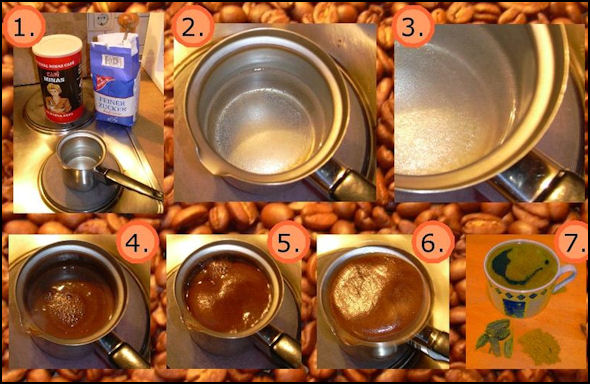
Making Turkish coffee
A different study found that people who drank decaffeinated coffee were half as likely to get rectal cancer as those wh didn’t drink it but researchers said the link could be due to lifestyle rather than decaffeinated coffee. Other studies show that coffee may mitigate damage caused by smoking. Creams made with it reduces the risk of skin cancer in mice. .
A study by the National Cancer in Tokyo suggested drinking three or more cups of coffee a day reduced the risk of colon cancer among women by 50 percent.
Image Sources: Wikimedia Commons
Text Sources: National Geographic, New York Times, Washington Post, Los Angeles Times, Smithsonian magazine, Natural History magazine, Discover magazine, Times of London, The New Yorker, Time, Newsweek, Reuters, AP, AFP, Lonely Planet Guides, Compton’s Encyclopedia and various books and other publications.
Last updated March 2022

